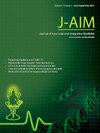用斑马鱼模型研究阿育吠陀药用植物对中枢神经系统的影响
IF 1.9
Q3 INTEGRATIVE & COMPLEMENTARY MEDICINE
引用次数: 0
摘要
传统的印度医学(阿育吠陀)在治疗中枢神经系统(CNS)疾病方面有着悠久的历史。阿育吠陀植物通常富含类黄酮、木脂素、甾醇、单宁和生物碱,对人类和啮齿类动物都有有效的抗炎、抗氧化、神经保护和嗜神经作用。斑马鱼(Danio rerio)已成为一种有用的模型物种,也是一种强大的脊椎动物体内系统,用于中枢神经系统疾病建模和药物筛选。随着斑马鱼在包括中国和美国传统药物在内的广泛药物治疗研究中越来越多的应用,我们在这里讨论各种阿育吠陀药用植物的中枢神经系统作用,以及如何利用斑马鱼模型进一步阐明这些作用。我们还评估了使用斑马鱼模型研究阿育吠陀药物治疗的现有挑战和局限性,并概述了该领域未来的转化研究方向。本文章由计算机程序翻译,如有差异,请以英文原文为准。
Zebrafish models for studying central nervous system effects of Ayurvedic medicinal plants
Traditional Indian medicine (Ayurveda) has a long history of treating central nervous system (CNS) disorders. Ayurvedic plants are typically rich in flavonoids, lignans, sterols, tannins and alkaloids that exert potent anti-inflammatory, anti-oxidant, neuroprotective and neurotropic effects in both humans and rodents. The zebrafish (Danio rerio) has emerged as a useful model species and a powerful vertebrate in vivo system for CNS disease modeling and drug screening. As zebrafish continue to demonstrate their growing utility for studying a wide range of pharmaceutical therapies, including Chinese and American traditional medicines, here we discuss CNS effects of various Ayurvedic medicinal plants, and how they can be further elucidated using zebrafish models. We also evaluate the existing challenges and limitations of using zebrafish models for studying Ayurvedic pharmacotherapy, as well as outline future directions of translational research in this field.
求助全文
通过发布文献求助,成功后即可免费获取论文全文。
去求助
来源期刊

Journal of Ayurveda and Integrative Medicine
INTEGRATIVE & COMPLEMENTARY MEDICINE-
CiteScore
4.70
自引率
12.50%
发文量
136
审稿时长
30 weeks
 求助内容:
求助内容: 应助结果提醒方式:
应助结果提醒方式:


